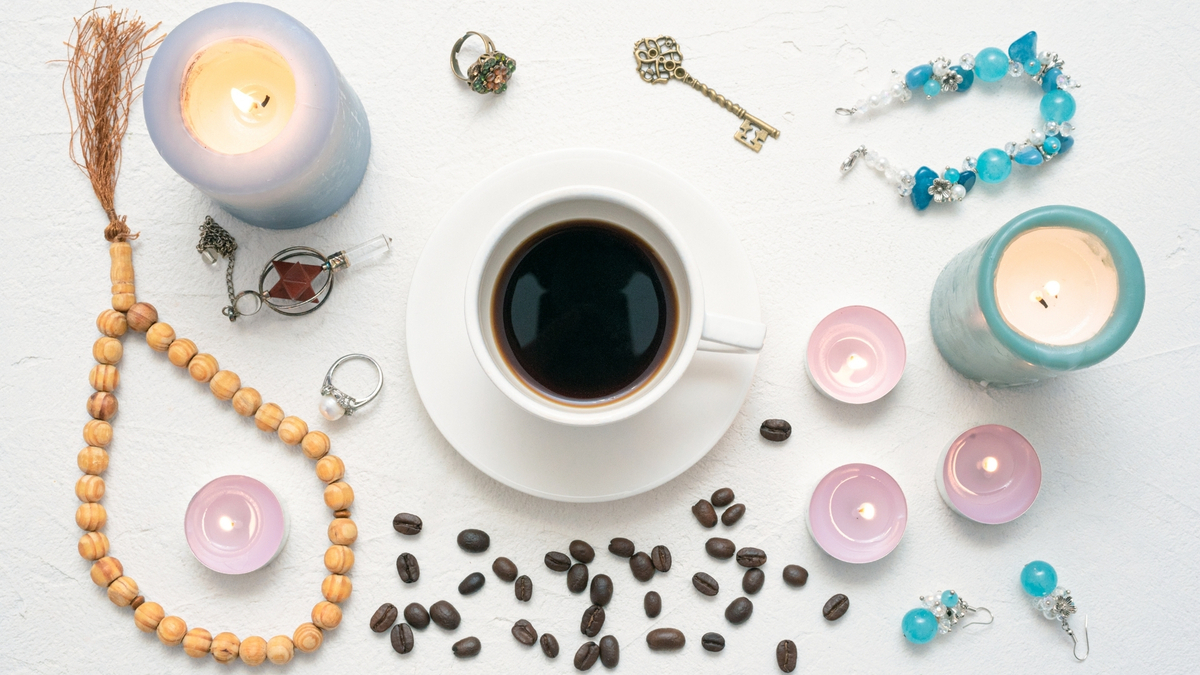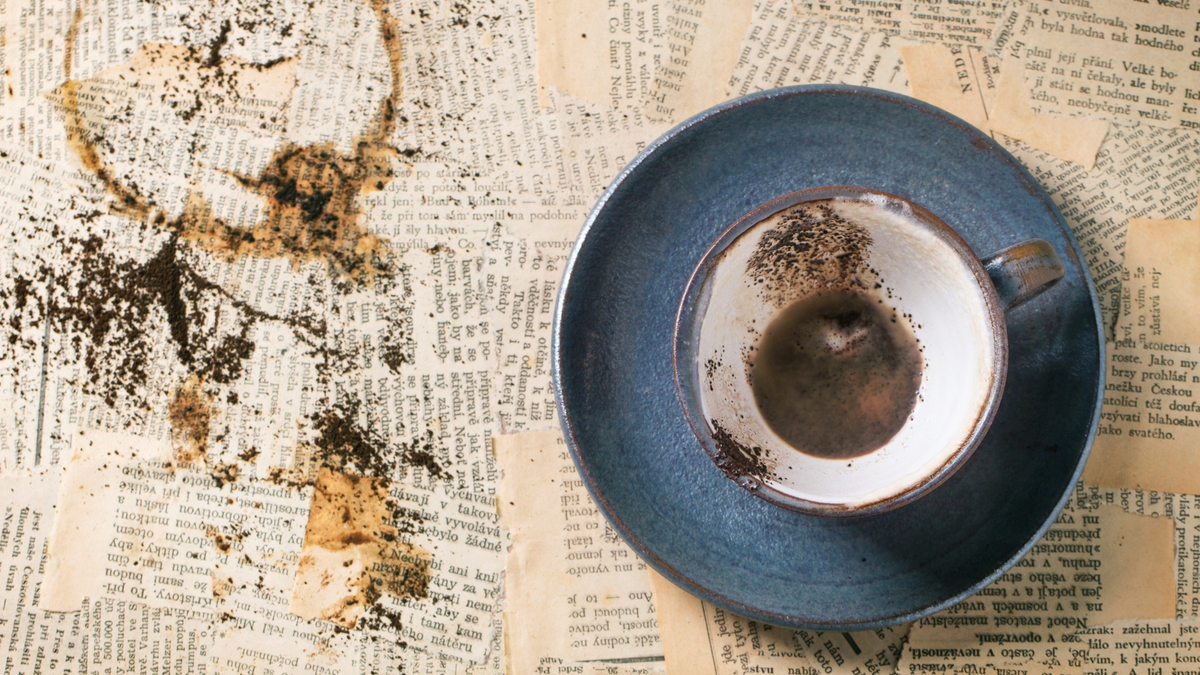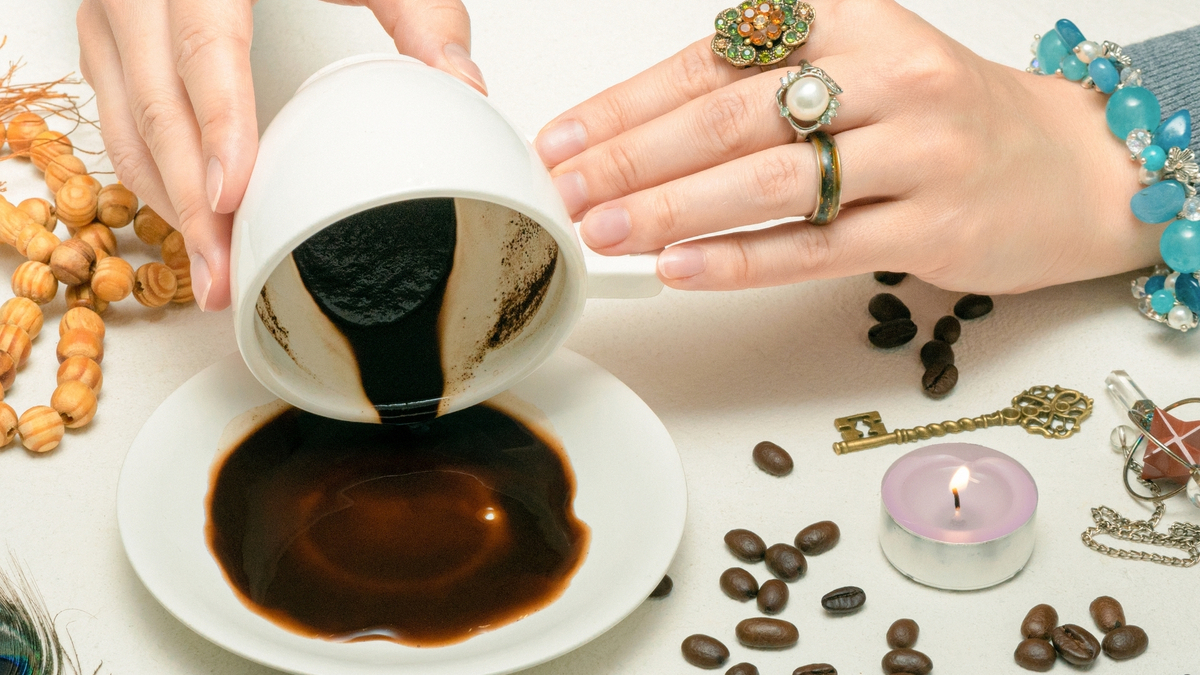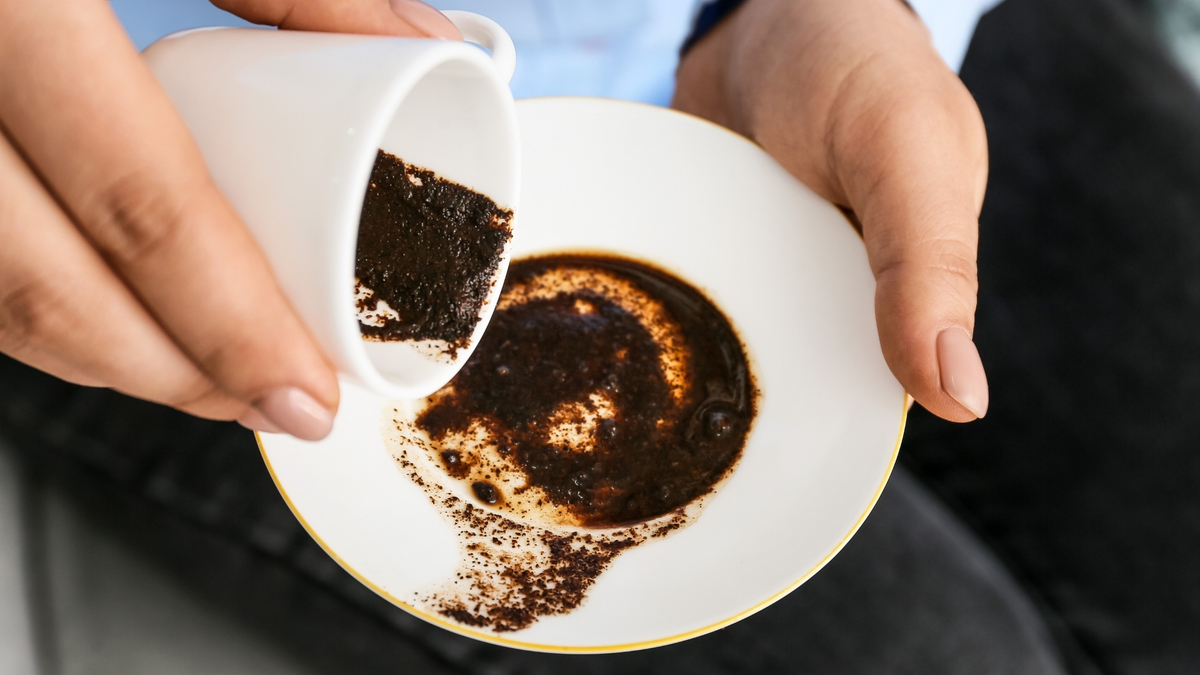Table of contents
General Meaning of Caffeomancy

Coffee-mancy is one of the divinatory methods that attract the most attention in the popular imagination. After all, we see few people who know how to read coffee grounds and we have even less knowledge of research sources when this technique is compared with cartomancy.
Therefore, in this article we bring you a little bit of the history of cafeomancy, reading methods, the meanings of the symbols and much more. Check it out!
Caffeomancy, history and how it works

To begin with, you need to understand what caffeomancy itself is, its historical trajectory and how it works in general ways. In this topic, we will answer all these questions. Check it out right below!
What is Caffeomancy
Caffeomancy is divination through the interpretation of coffee grounds. The consulter should drink a cup until he almost reaches the end, leaving behind a little of the liquid and grounds so that the symbols can be formed.
The history of this divinatory art is quite rich and the methods of reading quite varied, and can even change from family to family. But to know more details about it, continue reading the article!
History of Caffeomancy
Caffeomancy originated in Arab countries, where coffee was first produced as a beverage. However, this art had both local and foreign inspirations, specifically inspired by tasseomancy (the reading of tea leaves), which originated in China.
Over the centuries and migrations, the methods of reading have become more and more diverse, to the point that today we have different interpretations from family to family.
Nowadays, both caffeomancy and tasseomancy are practiced mainly by families of gypsy ethnicities (such as the Roma or Sinti), Orientals, Eastern Europeans, or among pagans, witches and mystics in general. In the modern West, these arts are almost forgotten or are idealized in a stereotypical way.
How it works
The reading in cafeomancy works, basically, with the mental preparation to focus the mind in the question that one wishes to answer, in the preparation of the coffee (made in different ways, sometimes not filtered, for better formation of lees), in the consumption of the drink and, then, with methods of draining the little left behind by the consulter and in the interpretation of the formed images.
There are several ways to prepare, drink, drain and interpret the symbols, which will be covered later, so be sure to keep reading!
The parts of the cup used in the reading
In coffee pottery, each part of the cup indicates a different element, mainly the temporal division. For many, the handle of the cup is like a division in half between past (to the left of the handle) and present (to the right). However, it should be noted that the past and present are only shown in the uppermost parts, near the mouth of the cup. Below that we identify the future and, the closer to the bottom, the moredistant.
When a symbol appears near the wing, on the same path as it, some interpret that it speaks directly about the person themselves and an inner issue of theirs, rather than a time period.
There are also those who read the lees following the method that what appears on the saucer (also stained with the lees) speaks of the present, and that the mouth already speaks about the future, still following the same logic of the more to the bottom, the further ahead the events will occur.
Determining the Date
Setting an exact date from cafeomancy is a tricky task and for the sake of honesty, it will never be possible to have an answer exactly. However, with consistent practice, one may become better able to surmise a time by following their chosen method of determining the time according to the areas of the cup.
Don't get frustrated if the first few times you don't predict the dates very well. This is all practice and we all improve our knowledge and techniques with time, adaptation, error correction and persistence.
The methods of reading, how it is made and the coffee recipe

As mentioned before, there are dozens, if not hundreds of reading methods in cafeomancy, as this is primarily a family-oriented art and very much tied to the local cultures of the consulters. So here we have gathered some general reading methods, along with more information about how the reading is done, from planning to the act itself, and a Turkish coffee recipe.Check it out below!
How the reading is done
First and foremost, the consulter must provide a calm and centered environment, both outwardly and inwardly. More detail on this will be covered below, but we can reiterate that a clear and focused mind are essential for divination.
It is also important for the diviner to keep an open mind, not expecting to find this or that drawing, as this hinders the interpretation of whatever divinatory art it is.
Another essential point is that you pay attention to the positioning of each symbol, the size, which one is next to which, and all these details. If you need to, take a notebook with you in which you can write down your observations.
Calm and quiet environment
As with any method of divination, for cafeomancy we need a calm environment that allows the diviner to maintain the concentration needed to interpret the symbols and their positions correctly, as well as to tune into their intuition - which is the key element to any divination.
What would be a quiet environment depends from person to person. What is common is that the person has a specific environment for that without too many distractions.
The beginning of reading
In a certain way, the reading already begins in the very preparation of the coffee, even more so when a traditional and almost ritualistic method is followed. Moreover, another important point is when the person who asks the question starts to drink, already having to mentalize his question from that moment on.
There are also those who start by lighting candles, doing mentalizations, and taking advantage of the moment when the other drinks (or themselves) to prepare the mind for the reading, already connecting with the energies involved.
Traditional method
As mentioned, there is no single traditional method, so we have gathered some methods mentioned in the book "Caffeomancy: reading the coffee grounds" by Javert de Menezes.
One of her interviewees, of Greek descent, leaves a little coffee in the cup, the lid on, turns it towards her heart and lets it rest for a few minutes before reading. According to her, one should have an exclusive cup for readings. She also places a black tourmaline (or another crystal with similar properties) next to the cup to avoid negative energies.
Another interviewee, who is Russian, learned from her grandmother to use a cup with only one handle and to always start reading the handle in an anticlockwise direction. She starts by reading what is on the walls and then reads the bottom. For her, vertical symbols that run along the entire height of the cup should be interpreted as the passage of time, of one month or so.
Dona Sila, who was interviewed from Turkey, reads clockwise. Her reading method is similar to the previous one.
In summary, we can see that traditional reading methods are varied, unique to each family and culture. If you want to learn caffeomancy, you can use one of the methods mentioned in this article and, with practice, formulate your own unique method and interpretations.
Practical method
Some modern practitioners look for quicker ways to practice coffee-mancy, especially at times when time is short or when they feel uncomfortable practicing in public. If this is the case for you, you can follow the methods mentioned by just turning it upside down and letting the dregs drip off before unturning it.
Don't worry about stares - the truth is that no one is paying attention to or cares about the person at the next table who turned the cup on the saucer. If any attendant asks if you can remove the dishes, just politely say no.
In case you also don't have a crystal to carry with you or fear it will attract attention, it's not necessary. You can still block negative energies with methods of focus and personal energy rebalancing, or even silent prayers.
And, if you can't rotate the cup or bring it closer to your face, either for time, locomotion or discretion, the cell phone can be a good ally: photograph the cup, taking care that the images show the positions of each dregs well. Then, you can use the photos taken to do your reading more calmly.
Turkish coffee recipe
Turkish coffee is different from the others both for its unique preparation method and the way it is served. It is made with coffee ground to extra-fine and, unlike the Brazilian preparation, the powder is boiled with water and not filtered afterwards, and spices are added. The drink is much thicker and stronger than what we are used to.
To prepare this drink at home, you will need:
- extra-fine ground coffee;
- sugar (if desired);
- spices (if you like - the most commonly used would be cinnamon, star anise and cardamom);
- a cezve (a tool used to pour the coffee);
- mineral water.
If you can't find coffee that fine, you can use a special grinder, as the commonly used Brazilian coffee is too thick to be unfiltered.
According to uCoffee's recipe, you first add the water, sugar, and spices to the cezve and then bring it to a boil. When the water boils, remove, add the coffee, mix, and bring the cezve to a boil in three separate moments. Between each boil, let the drink rest and lower the foam.
After the third boil, let the drink rest to allow the powder to come down and then serve in small cups. It is not recommended to stir the drink before tasting it, as this causes the powder to rise. It is common for the drink to be served with a glass of water or a lump of sugar to prepare and cleanse the palate.
The symbols and what they consider the interpretations

To practice cafeomancy, it is not only necessary to know what each symbol means, but also what their characteristics and positions are, which influence the reading, along with a dose of intuition to unite one piece of information into another in a continuous narrative.
In this section, we will talk about how to know the context, location, size and thickness of symbols and how they influence interpretation. So read on to find out more!
The context
Analyzing the context is to understand the whole set of features and situations: where the symbol is on the cup, its size, its thickness, whether it is tilted, and also what symbols are around it.
In addition, it is necessary to know how to sew this information with the question raised by the consulter, and not just say what x and y mean. With the information that we will show you below and a consistent practice, little by little you will perfect this art.
Placement
The location where the symbol appears can indicate whether it is nearer or farther in the future. Sometimes it can be that symbols refer to the past, although this is rare and only if it is related to the present/future topic.
In certain methods, such as those of two interviewees by Javert de Menezes, when a vertical symbol stretches across the entire height of the cup, one can use it to calculate a time marking of approximately one month.
The thickness
The most common interpretations indicate that weaker symbols would generally involve a lack of focus by the consulent, who needs to better outline his goals and doubts. On the other hand, when it is too thick, it would indicate a lot of accumulated and/or blocked energy on the subject in question.
Thus, the symbols in more "normal" thickness, medium and with clear strokes, would be the indicators of a focused mind and balanced energies.
The sizes
The size of the symbols indicates their importance to the subject in question and the impact on the life of the consulter. The larger it is, the more attention should be paid to that specific meaning or area of life and the more profound may be its physical and emotional consequences.
The smaller ones can be read as complementary to the larger symbols around them, or something that will happen, of enough importance to appear in the reading, but not to alarm the person. If they are next to larger symbols, they can perhaps indicate under what circumstances the prediction of the larger one will happen.
The main symbols of Caffeomancy

The interpretation of the symbols, like the methods of reading, can vary from family to family. Thinking like this, it would be almost impossible to delineate how each and every reader of the dregs interprets what they see.
Even so, we tried to gather here some general meanings associated with the most common symbols, using as reference the interpretations mentioned in Menezes' book. Check it out below!
Circles: cut, dotted, large and small
There are those who interpret the circles as symbols of cycles and infinity, eternity and the sense of perfection. Because of this, it can indicate cyclical themes of life, or even, an influence and/or proximity of divine beings.
This shape can also call the consulent's attention to be going in circles in a situation, and that he needs to make up his mind soon (spiral shapes can also indicate the same thing) - an interpretation that is very present for this symbol.
Large circles may indicate the end of a relationship, while small ones, a possible marriage. Circles with dots may predict success in love. When they appear in several numbers, they indicate a path to be followed for perfection and the achievement of goals. A cut circle announces the end of a problem, or the need for protection.
Lines: curved, straight and parallel
Lines and dashes can indicate paths, thoughts and duties, time, or even a number of people (especially when they appear together, side by side). Straight lines usually indicate determination and a clear, focused mind.
However, curved lines may foreshadow future difficulties or loss of direction. Parallel lines can be understood either as a certain amount of people involved, or (when there are only two lines) open paths ahead, or a new project. When the lines form a triangle, they foreshadow luck in love, manifestation of intentions and balance.
Heart
When a heart appears on the lees (and mind you: it's the symbolic heart, not the shape of the body organ), it always addresses themes of love, romance and passion. The heart alone would herald new relationships. However, if the heart seen appears broken, the prediction is one of termination and heartbreak.
A winged heart, on the other hand, foreshadows both a great passion and a high kind of love, probably connected with divine beings and spiritual devotion.
Pets
In cafeomancy, animals are related to behaviour, either of the person being consulted or people around them. Thus, they can indicate someone's personality, how they behave, or how they should behave in a certain situation.
Dogs are read by most people as symbols of loyalty, and may indicate that either the consulter is very loyal, or has loyal friends around them. It also advises keeping friends close and working on forgiveness.
A cat may warn the consulent not to come into contact with strangers at this time. This is the time to guard yourself with caution and work with the union of your physical and mystical side, which is strengthened.
For some, the horse is a symbol of masculinity, virility, courage and a free spirit, and may indicate a masculine presence or that this would be the energy of the consulter. It is also possible that it indicates a short and pleasant journey ahead.
An ox is a symbol of prosperity, work proposal, luck and fortune (as well as, since the past until today, cattle are used as a way to calculate someone's fortune). It also warns against spending unnecessary energy on fierce fights.
Rooster, on the other hand, that you should take care of your property, but be careful not to look ridiculous with unfounded authority.
Wild Animals
An elephant can symbolize loyalty, prudence, and foretells success, luck and abundance. Dolphins, on the other hand, refer more to the romantic side, foreshadowing love and joy. The spider brings warning to a possible self-centeredness and a time to wait to realize your goals.
A scorpion, however, warns against dangerous people around you who hide their true face. A snake would be a possible betrayal, enmities and diseases. A bat, on the other hand, calls attention to the night life taken, to a passion that consumes more than nourishes and that changes are on the way.
Objects
In general, the objects relate to events that the consulter is dealing with at the moment.
The hourglass also symbolizes the passage of time, patience and necessary action, but also a possible need or desire to return to the origins.
An anvil warns the consulent to resist temptations, but also not to miss opportunities. A scale warns that balance is necessary, as well as justice and prudence. An anchor speaks about stability, strength, security and fidelity.
A horseshoe, in some interpretations, portends unexpected fortune, luck, protection, and important new people in your life.
Weapons
In a general, symbols that relate to blades indicate cutting - of a phase of life, a situation, a relationship, etc.
A bow and arrow may indicate a forbidden love or that still must be conquered, battles, decision making and destiny defined. Knives foreshadow danger, fights and diseases. A sword, on the other hand, calls the consulent to be more assertive and that he has protection.
A sickle announces that the consulent will reap what he has sown. Or even (as the axe symbol), enemies at work and the need to cut people or situations from his life. A hammer would be perseverance, completion, justice and a crucial moment.
The shape of a firearm can be a call to action and courage to the consulant, but be careful: do not solve things with anger.
Furniture and kitchen items
The bed may foreshadow inconsequential sexual adventures, or a need for rest. A window, that the consulter must be careful not to be indiscreet or cynical. A table, to be more fair and clear in his words. A door, that new paths open.
A chair warns against the laziness of the consulter, which can harm him, and also about unexpected financial gains that will appear only if the consulter moves. A ladder speaks of the ascension and fulfillment of sex life and hitherto unfinished projects.
A fork may foreshadow a reward for hard work and guaranteed supplies. A ladle, family help and the need to face shyness. A bottle, however, warns of abusive, addictive relationships and emotional dependence.
Clothing and personal items
A hat means success and discipline. It can show how the consulter sees himself or the appearance of a rich man. A crown, on the other hand, predicts promotion at work and social ascension.
A cane would be a sign of help and necessary self-reflection. A pipe, that his masculine forces are in evidence and the possible experience of a forbidden love. The boot is the presence of a man interested in the consulter.
Plants
Images of trees speak about knowledge, firmness, growth and ascension. Therefore, it is a symbol of luck and good predictions in general. A loose leaf, good life and favorable news, or the sorrow of unrequited love. A bush, unexpected money.
Flowers can speak about spirituality, happiness, delicacy and love. It may be that someone who has hurt you apologizes. A bouquet of flowers announces joy in marriage and friendships (or that will come in the future), but also that the consulent may be missing someone.
Means of transport
The ship may indicate a journey with an uncertain destination, and may have to do with crossing from the natural to the spiritual world, either with births or deaths.
A train, the arrival of a loved one, maintenance of relationships and a likely monotony in routine. A plane speaks of the desire to escape routine and professional successes.
People
The shape of a ballerina indicates the help of some woman in your life, as well as hope, resolution of situations and a moment of lightness in life. Antique ladies usually address themes of the female world and energies of sensuality present.
However, they can also indicate empowerment, prestige and wealth, as well as the possible need for the consulent to revisit the past to understand their present. Children herald joy, childlike behavior and possible births. An indigenous format, healing and spiritual cleansing.
Magical and spiritual beings
They usually deal with themes of confirmation, cleansing and contact with "enchanted" situations - misunderstandings, illusions and the like. On the other hand, they also deal with themes related to the spirituality of the consulter.
Angels symbolise purity, goodness, youth and spiritual protection. Gods also foreshadow assistance and spiritual connection. The Devil, on the other hand, warns against rumours not to be heeded, the dangers of unruly living and the return of evil done.
A dragon can speak of success with protection, good opportunities and beware of addictions. The witch, spiritual protection, energy cleansing and fulfillment of wishes. Gnomes, to relax your seriousness and get closer to nature.
A mermaid announces that someone loved by the consulent is concerned about him, and further to put reason over feelings. It is also advised that if the consulent needs to make trips by water, keep caution.
Buildings
For some, the shape of a building can be read as financial success and possibility of growth, but risky. For others, the side of monetary loss is more present in the interpretations.
A church speaks of a rescue of spirituality, but beware of excessive pride. A castle, unexpected inheritances and important events. A house, future marriages, changes and news in family life. A wall warns the consulent not to be too closed, as this will hinder his evolution.
Body parts
A full face may indicate self-knowledge, courage, or a maternal presence (especially with more feminine looking faces). Masculine features may indicate help from a friend, responsibility, or spiritual issues to be resolved. A face seen in profile announces someone's desire for the consulter, or that it is necessary to face a problem head-on.
An ear indicates good health, friendships, and patience with someone who needs to be heard. Eyes would already speak about clarity, vision, enlightenment, knowledge and understanding, and a warning to pay attention to how you see the world.
Hands symbolize alliances, friendships, complicity; the consulent will be successful against situations of intrigue. Meanwhile, the feet foreshadow good times for travel and to beware of scandals.
The mouth indicates sexual dissatisfaction and the need for more attention to the person in the relationship. To see breasts in profile can indicate a strong sensual energy, pleasure, affection and welcoming. In front, it is a symbol of femininity and nutrition, which can announce a new love approaching.
The genitalia usually announce the presence of hidden desires. A penis shape is also usually read as a symbol of power, strength, victory in goals and protection. A vagina, on the other hand, speaks about sensuality, delicacy, and that the resolution of some problem is approaching.
Celestial Bodies
When the dregs form images reminiscent of these celestial bodies, they usually signify luck and important events, with a good chance of involving positive change and renewal.
The sun in particular is a symbol of success, happiness, investments and peace of mind. The crescent moon, on the other hand, speaks about growth, renewal and romance (it could be a romance approaching or a warning for the consulent to be more romantic).
However, there are those who interpret the moon in general as a symbol of intuition and connection with spiritual energies, luck, changes and to value what you have. And finally, as for a star, one could understand success at its peak and a strong protection. A shooting star calls attention to pending issues that need a quick solution.
Can anyone perform Caffeomancy?

Theoretically, anyone can learn caffeomancy, but since it is a divinatory practice, like any other, it is true that people who can connect better with their intuition can use it better, and the factors of rationality and theoretical learning are not essential.
But make no mistake, this does not mean that theoretical learning should be neglected in favor of just using your intuition. Everything must be in proper balance. But keep in mind that reading a list of meanings once will not make you an expert - not with caffeomancy, not with cartomancy, not with anything in life.
Caffeomancy is an art that requires study, practice, seriousness, a sharp intuition, a flexible and also analytical mind, capable of reviewing each act and catching any possible mistakes to then adapt for possible better results.
And, above all, persistence and deep respect are essential. Don't give up at the first frustration or because of laziness to follow the methods. In the same way, always remember that this is a centennial practice coming from specific cultures that must be respected. Caffeomancy is not a game just for fun in the "mystical world". It is serious, it is cultural, historical and must be respectedas such.

